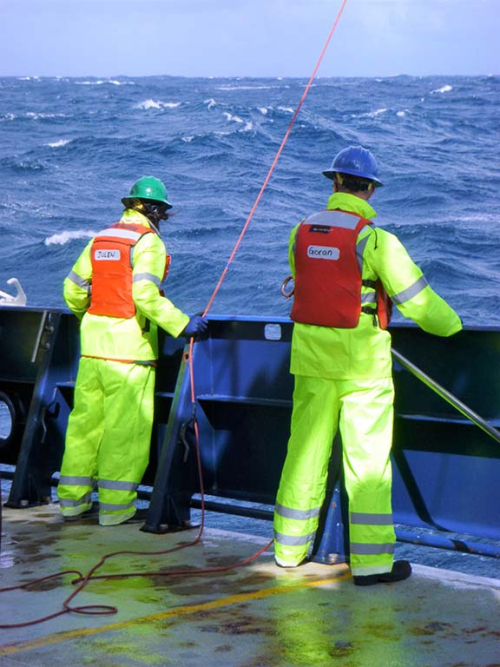
Revelle Blog #14 Past the Halfway Mark

Alec Yates is a Research Assistant at Victoria University of Wellington. He is currently working and reporting on the research occurring along the Hikurangi subduction zone on board the US research vessel Revelle.
We’re into day five at sea, with our recoveries just passing the halfway stage. The success rate has been excellent so far in terms of recovering usable data.
Of the 22 instruments we have recovered, only one sensor has shown signs of having recorded bad data. When you take into account that each instrument has four sensors – two measuring electrical energy and two measuring the magnetic field – that’s pretty good!
After a calm first day of recovery, we have had a couple days of pretty rough weather. It is only after recovering a few instruments in horizontal rain and large waves that you really appreciate the calm days! We’ve got about four days left at sea, with some more bad weather on the horizon.
Many onboard are planning to use the current lull in the weather to catch up on some much-needed sleep, which is hard to come by when the ship is moving around so much. We are currently to the north-east of Castlepoint, about 100 kilometers offshore, as we continue our journey south towards Wellington.
Given the level of interest in the Hikurangi subduction zone, it is not uncommon for other research groups to take advantage of planned voyages to undertake research of their own. So, with that, we have new installations onto the seafloor!
Three GNS-owned pressure sensors were installed successfully overnight to the delight of onboard GNS technician Neville Palmer, who had to work through some early technical issues. These will now record vertical movements of the seafloor by measuring water pressure changes.
These pressure sensors will record changes in the seafloor associated with slow slip earthquakes. These are like regular earthquakes, but occur over a much longer time period. This means that we often cannot feel them without sensitive instruments, as energy is released slowly over weeks to months rather than in a few seconds.
Slow slip earthquakes are interesting to scientists because they occur in areas where the plates are sliding past each other more freely. Determining what slow slip earthquakes mean for future large earthquakes is still something that is not fully understood
Disclaimers and Copyright
While every endeavour has been taken by the East Coast Lab Hikurangi Subduction Zone M9 to ensure that the information on this website is
accurate and up to date, East Coast Lab Hikurangi Subduction Zone M9 shall not be liable for any loss suffered through the use, directly or indirectly, of information on this website. Information contained has been assembled in good faith.
Some of the information available in this site is from the New Zealand Public domain and supplied by relevant
government agencies. East Coast Lab Hikurangi Subduction Zone M9 cannot accept any liability for its accuracy or content.
Portions of the information and material on this site, including data, pages, documents, online
graphics and images are protected by copyright, unless specifically notified to the contrary. Externally sourced
information or material is copyright to the respective provider.
© East Coast Lab Hikurangi Subduction Zone M9 - www.eastcoastlab.org.nz / +64 6 835 9200 / info@eastcoastlab.org.nz
